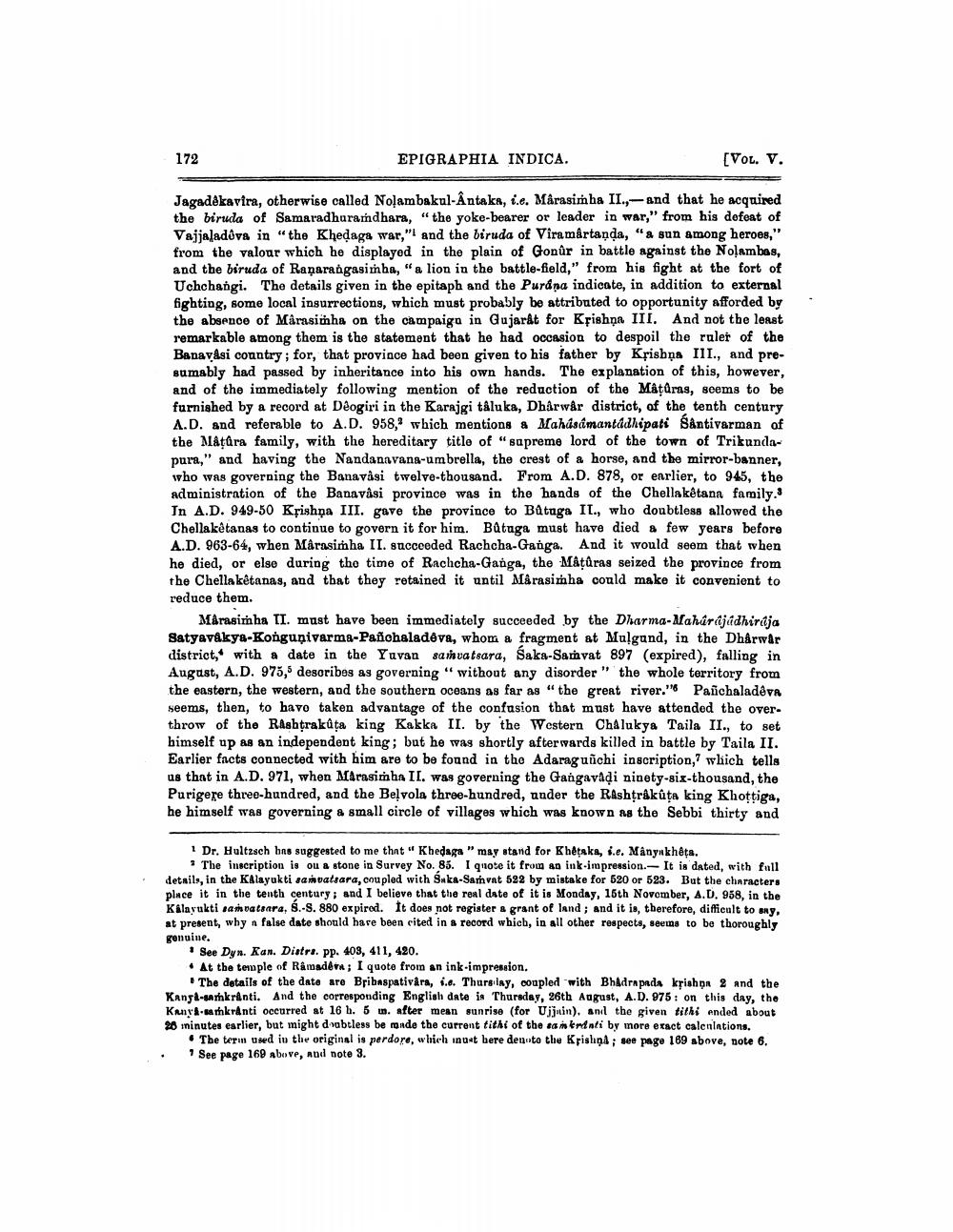________________
172
EPIGRAPHIA INDICA.
[Vol. v.
Jagadékavira, otherwise called Nolambakul-Antaka, i.e. Marasimha II.,- and that he acquired the biruda of Samaradhurandhara," the yoke-bearer or leader in war," from his defeat of Vajjaladóva in "the Khedaga war," and the biruda of Viramartanda, "& sun among heroes," from the valoar which he displayed in the plain of Gonûr in battle against the Nolambas, and the biruda of Raņarangasimha, "a lion in the battle-field," from his fight at the fort of Uchchangi. The details given in the epitaph and the Purana indicate, in addition to external fighting, some local insurrections, which must probably be attributed to opportunity afforded by the absence of Marasimha on the campaign in Gujarat for Kpishņa III. And not the least remarkable among them is the statement that he had occasion to despoil the ruler of the Banavåsi country; for, that province had been given to his father by Krishņa III., and presumably had passed by inheritance into his own hands. The explanation of this, however, and of the immediately following mention of the reduction of the Mâțuras, seems to be furnished by a record at Déogiri in the Karajgi tâluka, Dharwår district, of the tenth century A.D. and referable to A.D. 958, which mentions & Mahúsamantadhipati Santivarman of the Måtūra family, with the hereditary title of "sapreme lord of the town of Trikundapura," and having the Nandanavana-umbrella, the crest of a horse, and the mirror-banner, who was governing the Banavasi twelve-thousand. From A.D. 878, or earlier, to 945, the Administration of the Banavasi province was in the hands of the Chellaketana family: In A.D. 949-50 Krishna III. gave the province to Batuga II., who doubtless allowed the Chellaketanas to continue to govern it for him. Butaga must have died a few years before A.D. 963-64, when Marasimha II. succeeded Rachcha-Ganga. And it would seem that when he died, or else during the time of Rachcha-Gaiga, the Mâțuras seized the province from the Chella kêtanas, and that they retained it until Mårasimha could make it convenient to reduce them.
Marasimha II. must have been immediately succeeded by the Dharma-Mahúrájádhiritja Satyavákye-Konguņivarma-Panohaladeva, whom a fragment at Mulgand, in the Dharwar district, with a date in the Yavan samvatsara, Saka-Samvat 897 (expired), falling in August, A.D. 975, describes as governing "without any disorder " the whole territory from the eastern, the western, and the southern oceans as far as "the great river." Panchaladva seems, then, to havo taken advantage of the confusion that must have attended the over. throw of the Rashtrakata king Kakka II. by the Western Chalukya Taila II., to set himself up as an independent king; but he was shortly afterwards killed in battle by Taila II. Earlier facts connected with him are to be found in the Adarag uñchi inscription, which tells us that in A.D. 971, when Marasimha II. was governing the Gangavadi ninety-six-thousand, the Purigere three-hundred, and the Bel vola three-hundred, under the Rashtrákůta king Khottiga, he himself was governing a small circle of villages which was known as the Sebbi thirty and
1 Dr. Hultzsch bns suggested to me that "Khedaga" may stand for Khetaka, s.e. Mânyukhêţa.
The inscription is ou a stone in Survey No. 85. I quote it from an ink-impression. It is dated, with full detaily, in the KAlayukti samvatsara, onupled with Suka-Samvat 522 by mistake for 620 or 523. But the characters place it in the tenth century, and I believe that the real date of it is Monday, 15th November, A.D. 958, in the Kalavukti samvatsara, S.-S. 880 expired. It does not register & grant of land ; and it is, therefore, difficult to any at present, why n false date should hare been cited in a record which, in all other respects, seems to be thoroughly genuine.
See Dyn. Kan. Distra. Pp. 403, 411, 420. • At the temple of Ramadere; I quote from an ink-impression.
The details of the date are Bribaspativara, 1.6. Thursilay, coupled with Bhadrapada krishọn 2 and the Kangå-sarhkránti. And the corresponding English date is Thursday, 26th August, A.D. 975 : on this day, the Kanya-kathkranti occurred at 16 h. 5 in. after mean sunrise (for Ujjtin), anil the given tithi ended about 28 ininutes earlier, but might drabtless be made the current tithi of the saikninti by more exact calentations,
• The term used in the original is perdoro, which inast bere deuoto the Krishna, see page 169 above, note 6. • See page 169 above, and note 3.




